Course Syllabus
Syllabus Guide
This page offers a guide for the various components for effective syllabus development. Minimum syllabus expectations vary across campus, so please:
- Review and consider what options will best serve student learning in your course
- Consult your College and departmental expectations and guidelines
- It is a permanent record of a course's goals, activities, resources and learning which is utilized for equivalency, articulation and accreditation purposes
- It is an agreement between the instructor(s) and students about how the course will function
- It describes the course expectations for both the students and instructors
- It identifies the critical course resources needed for success
- As one of the first course materials the students interact with, it sets the tone for the course and instructor-student interactions
Your syllabus should be VALUABLE to your students
- A useful and usable document to guide student success in your course
- Something used often by the students (beyond the first day)
- Shared before the first class meeting (where possible)
- A guide to successful attainment of course goals
- Include a projected schedule of class meetings, assignments and other significant activities
- Universally designed syllabus - UDL Universe, Sonoma State University
- UDL Syllabus - CAST
- Succinct
- A resource for all critical information to best manage the course
- Free of jargon and ambiguity
- Utilizes headings and sub-headings
- Logically sequenced
- Accessible to students 24/7 (students have many commitments & work at all hours of the day)
- Accessible on our Learning Management System (LMS)
- Blackboard or CORE
- Greater accessibility and flexibility
- Access to a diverse range of resources in a variety of formats
- More opportunities for student engagement
- More opportunities to learn
- Complies with accessibility standards
- Section 508 of the Rehabilitation Act of 1973
- Web Content Accessibility Guidelines (WCAG) 2.1
- Accessibility and Policy - UDL on Campus (CAST)
- Accessible on our Learning Management System (LMS)
- A way to communicate YOUR ENTHUSIASM for the course
Your syllabus should comply with the minimum requirements and expectations of the UT System and your College. It establishes the expectations and requirements for the course instructors and students.
Basic Course Information
This information should, where appropriate, duplicate what appears in the Course Catalog and College Communications.
- Course Number and Name/Title
- Semester and Year
- Credit Hours
- Department/Program and College
- Course Description
- Focal course concepts and experiences, course formats (online, hybrid, didactic, team-based, simulation, lab, etc.)
- Course pre-requisites and co-requisites (where appropriate)
- Course Director contact information
- Name, title, office address, preferred phone number, UTHSC email
- Office hours (whether online or face-to-face)
- Course Instructors and Course Assistants
- Name, title, office address, preferred phone number, UTHSC email
- Office hours (whether online or face-to-face)
- Course Logistics
- Meeting times/days, building and room/lab numbers and location (link to campus map)
- Other key course information
- Course texts, journal articles, LibGuides, websites and other learning materials
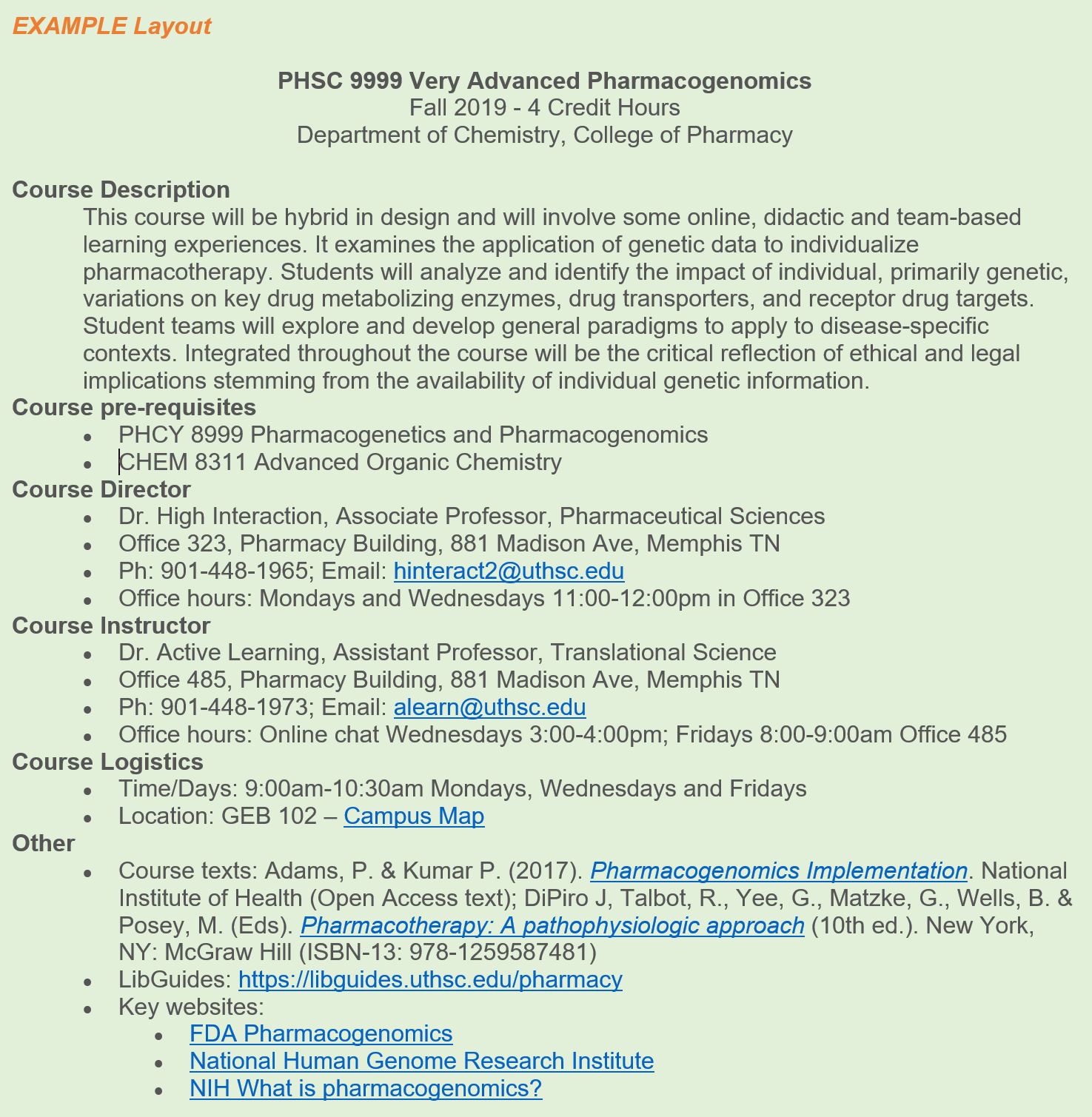
- Course Design (name and brief description of course structure, include instructor and student roles)
- If not previously stated, a brief overview of course's 'fit' and value within the program curriculum
- Course goals should be...
- SMART (acronym)
- Utilize Bloom's Revised and Digitalized Taxonomy (cognitive hierarchy)
- Consider what Threshold Concepts will be attained
- Remember, learning is a CHANGE in function, behavior and/or thinking
- Framed as... "On completion of the course, the students will be able to..."
- Linked to your department, college and/or accrediting organizations' standards and competencies
- Linked specifically to your assessment activities (see more in assessment activities below)
- SMART (acronym)
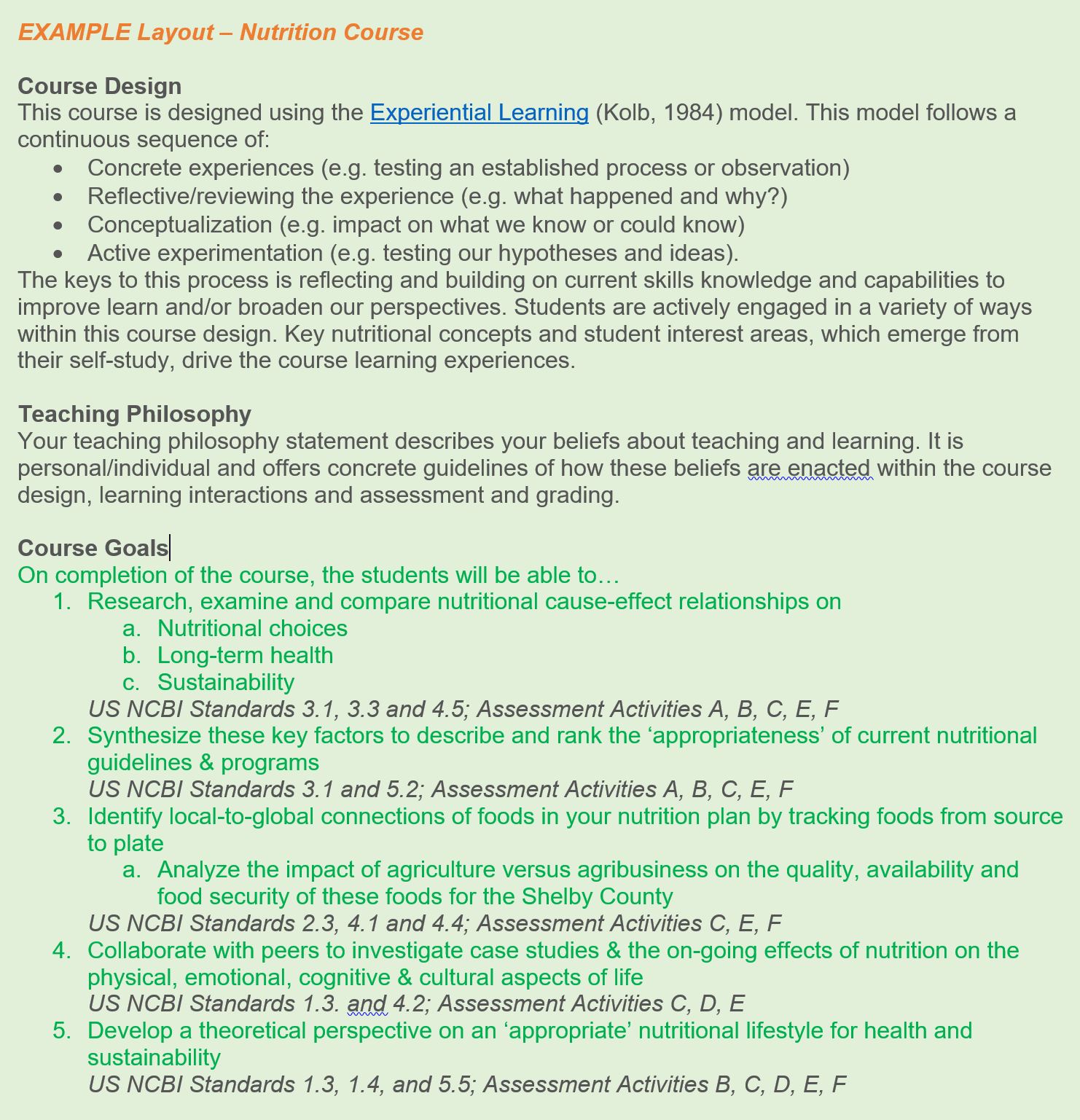
Assessment determines to what degree the student has attained the stated course goal(s). There are two parts to assessment:
- Assessment activities are the experiences from which the assessment data is collected using an appropriate assessment tool
- Assessment tools determine the grade, feedback, rank, etc. of each assessment activity
Assessment Activities
- Assessment activities include: written assignments (evaluations, analyses, summaries, etc.), portfolios, performances, problems/challenges, matching or ranking activities, etc.
- Assessment activities should be in a similar context or format to the ways the students learned the skills, knowledge and capabilities
- Link assessment activities to the specific course goal(s) which they are aligned
- Aligning Assessment with Outcomes - University of New South Wales, Sydney
- Aligning Assessments to the Objectives - Missouri State University
- Why Should Assessments, Learning Objectives, and Instructional Strategies be Aligned? - Eberly Center, Carnegie Mellon University
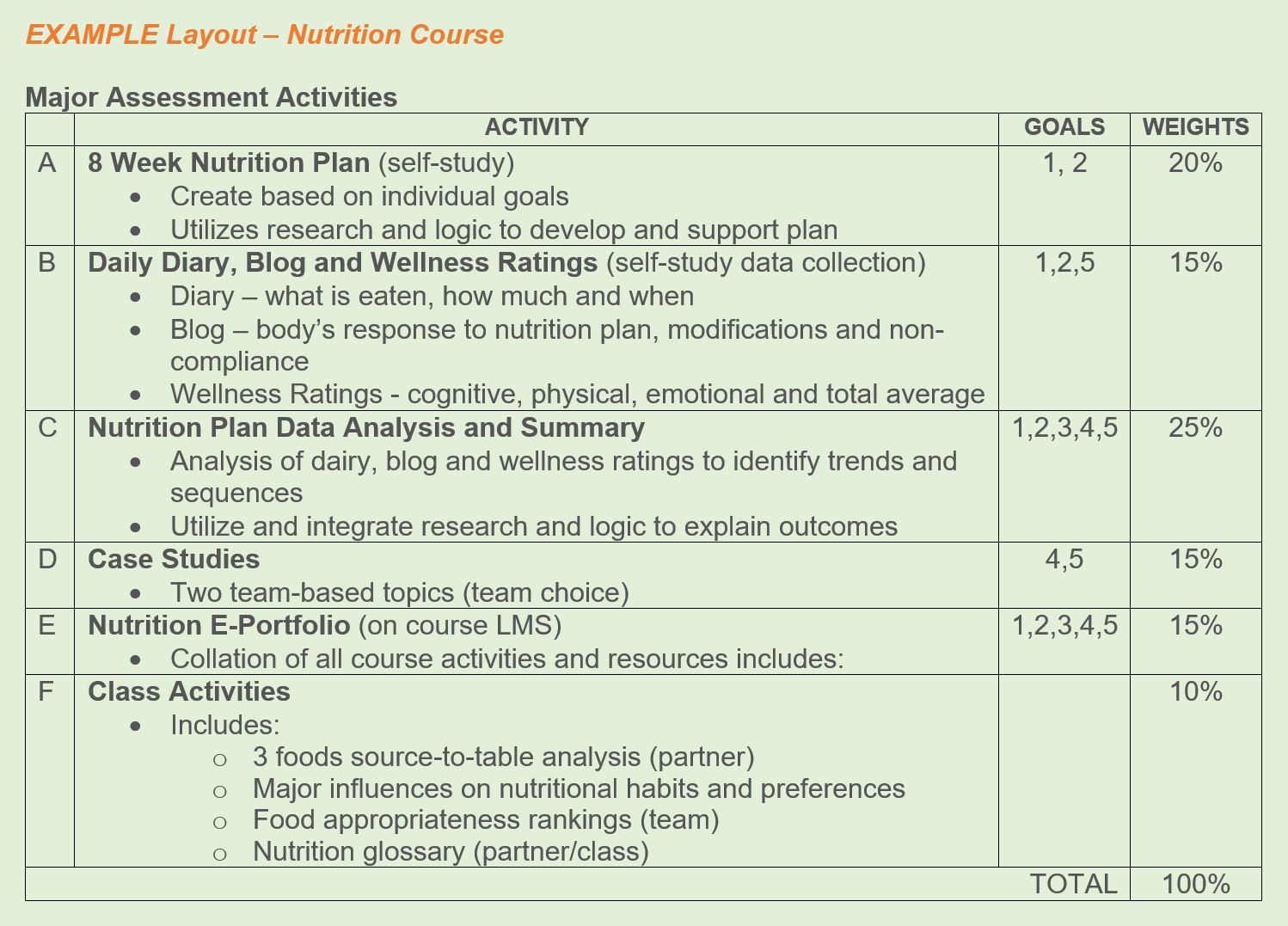
Assessment Tools
- Assessment tools include: checklists, multiple-choice quizzes, rating scales, rubrics, standardized
tests, etc.
- These tools and/or related guides should be provided to the students at the start
of the semester to guide their efforts and preparation
- Rating scales and rubrics are designed to not only assess student performance but guide their practice and learning efforts
- Study guides (typically conceptual topics and/or themes or broad questions) function in a similar way
- Assessment tools should be valid and reliable
- "...criteria that differentiate the grade levels should be clear and relevant to the goals we have set for that test or assignment," (Weimer, 2015)
- These tools and/or related guides should be provided to the students at the start
of the semester to guide their efforts and preparation
Grading
Grading is the established process for communicating the instructor(s) interpretations of the assessment activity outcomes. The instructor utilizes the assessment tool to determine to what degree a student has learned or performed during the assessment activity. Based on the grading policy stated in the syllabus, a grade is assigned for each assessment activity.
When developing a grading policy:
- Align with your College/department's guidelines
- Determine score or percentage ranges for each grade
- Assign weightings based on complexity (higher cognitive/skill functions)
- "The more an assignment counts, the harder students work on it," (Weimer, 2015)
- The threshold concepts or skills
- Where appropriate, break larger graded assessment activities into smaller progressive/sequenced activities
- Clearly articulate what the numeric grade represents (e.g. below expectations, meets expectations, exceeds expectations, etc.)
- Considerations
- Assignment turnaround time (the more efficient the more effective the feedback provided)
- Anonymity (names removed from assessment activities)
- Assignment and test submission format(s) - consider universally designed assignments
When developing your grading strategy and policy, ensure you will be able to...
- Clearly differentiate between different standards of performance
- Confidently state that the assigned grades accurately reflect the degree of mastery of stated course goals
- Comply with entire course grading policy stated in the syllabus
- Late submissions, resubmissions and regrading?
- Working earlier on an assignment, students are more likely to score higher and later starting students are more likely to score lower (Edwards, et al., 2009)
- Ethical considerations?
- Is it a double standard? (Miller, 2006)
- Acceptance of late submissions punishes the students who complied with the grading policy and expectations?
- Late submissions, resubmissions and regrading may provide those students access to critical information not available to those who submitted before due dates?
- What if regrade or resubmissions result in a lower grade?
- Impact on student behaviors? (who are the beneficiaries and why?)
- Does it encourage late or poor quality work for initial submission?
- Applicability to authentic/real-world practices?
- Extra time needed to support such policies?
- Extra credit?
- Value and meaningfulness of such an opportunity?
- Ethical considerations?
- Impact on the accuracy of the grade in relation to the course goals? If students needed the extra credit, it implies they did not attain the level of learning the grade suggests?
- "A common complaint with the use of extra-credit is that the practice promotes grade inflation and is used to positively effect student satisfaction," (Miller, 2006)
- Applicability to authentic/real-world practices?
- Impact on student behaviors? (who are the beneficiaries and why?)
- Research by Allevato & Edwards (2013) indicates that "offered bonus did not appear to have any positive effect on student behavior class-wide,"
- True availability to all students?
- Research by Miller (2006) indicated "...females were more likely to take advantage of the extra credit opportunities than their male counterparts"
- What do extra credit opportunities imply about course structure and grading system?
- Impact on validity and reliability?
- Extra time and effort needed to support such policies?
- Plagiarism and other forms of cheating?
- Late submissions, resubmissions and regrading?
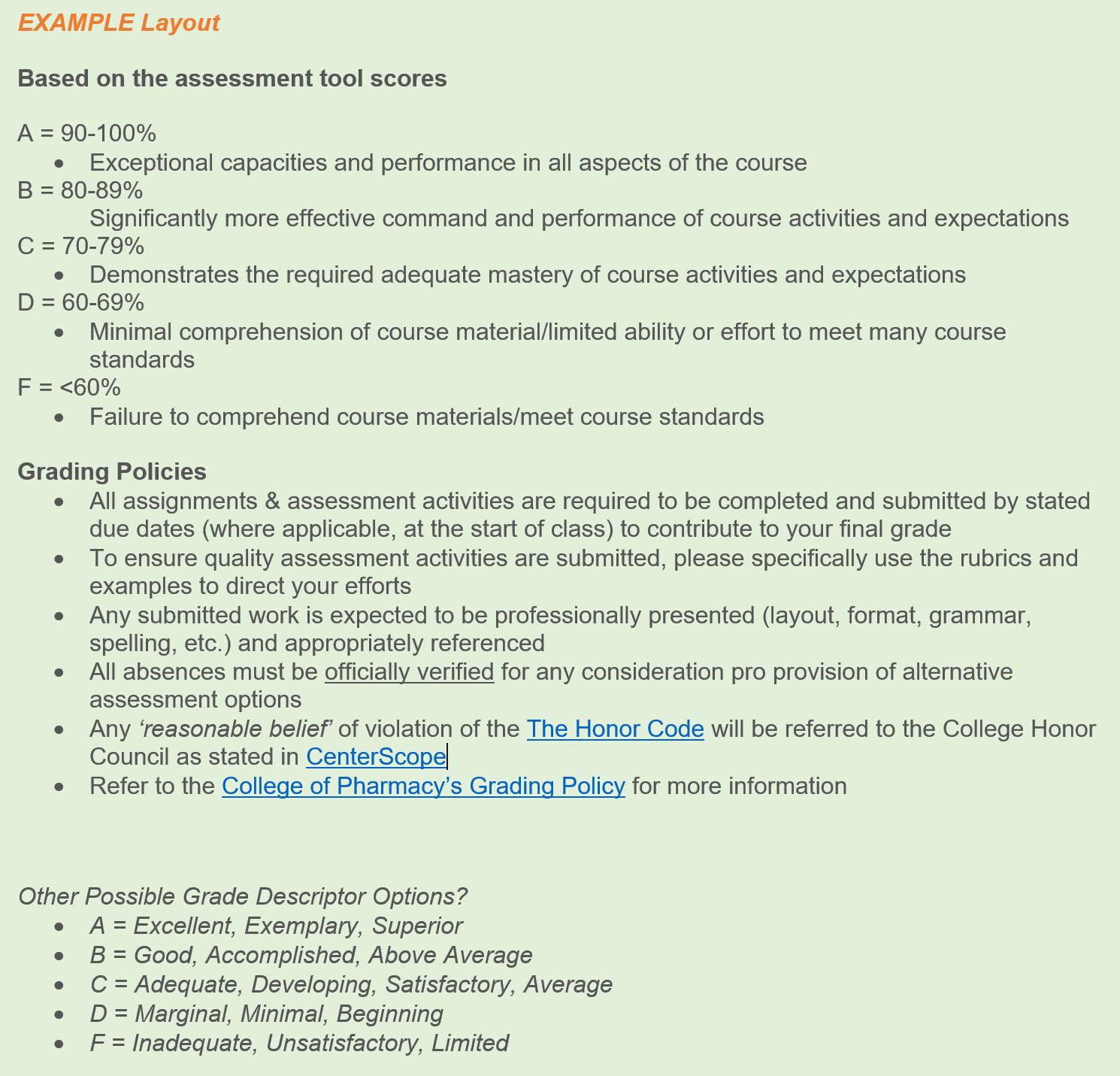
References and Resources
- Allevato, A. & Edwards, S. (2013). The effects of extra credit opportunities on student procrastination. Frontiers in Education Conference, IEEE
- Edwards, S., Snyder, J., Allevato, A., Perez-Qui´nones, M., Kim, D. & Tretola, B. (2009). Comparing effective and ineffective behaviors of student programmers. Fifth International Workshop on Computing Education Research - ICER. Berkeley, CA: ACM Press
- Developing a Grading System - Illinois State University
- Grading Student Work - Vanderbilt University
- Miller, B. (2006). Extra credit: Does the systematic use have an effect on student learning?24th EuroCHRIE Conference, Thessaloniki, Greece
- Schinske, J. & Tanner, K. (2014). Teaching more by grading less (or differently). CBE Life Sciences Education, 13(2), 159-166
- Weimer, M. (August 26, 2015). Using grading policies to promote learning. Faculty Focus, Magna Publications
These include UT System, University, College, Program and course specific policies. Where ever possible, utilize proactive (what to do) statements.
Policies and Procedures to Consider
- Assessment Activity Submissions
- Attendance
- Is there any policy for the course? (check College or departmental policies)
- Any official verification for missed assignments and graded activities required?
- Procedure for notifying Course Director of absence?
- Inclement weather or emergencies?
- Religious observances and accomodations?
- Academic Accommodations
- Technologies expectations and requirements (including for exams and assignments)
- Academic Technologies and Tech Tools
- Learning Support Tools and SASSI
- Remediation (check College policy)
- Cell phones and other mobile technologies
- They are becoming an ever-increasingly important learning device for students.
- A possible policy statement: In respect and courtesy for all, cell phones will only be utilized for relevant class activities.
- Communication Expectations
- Instructor-student and student-student
- Respectful and professional protocols
- Netiquette
- CenterScope (Student Handbook) policies and guidelines
- Copyright, Peer-to-Peer and File Sharing
- Copyright Guidance (Health Science Library)
- Dress Codes and Equipment
- Safety, laboratory, simulation, clinicals, course presentations, etc.
- Drop/Withdrawal Dates as per College policy
- Equity and Diversity
- Honor Code
- Professional Conduct
- Discussions, comments and feedback
- In-class and online etiquette
- Team interactions
- Student Responsibilities
- This can assist students is clarifying the basic responsibilities for the course.
Possible examples include:
- Reading the syllabus, course schedule and assessment activity guides, rubrics or rating scales thoroughly
- Seeking clarifications as soon as possible
- Participating thoughtfully and constructively in class, online and group discussions/projects
- Meeting all assignment expectations and completing and submitting them electronically by stated due date
- Collaborating positively and fairly with teammates to successful complete assignment requirements
- Bringing appropriate electronic devices & resources to class to efficiently & effectively participate in class activities
- This can assist students is clarifying the basic responsibilities for the course.
Possible examples include:
- Center for Healthcare Improvement and Patient Simulation (CHIPS)
University Academic Services
Schedule or Course Map
For students, the projected course schedule can be one of the most valuable sections of the syllabus. It enables students to better plan their time for the semester and subsequently, meet or exceed course expectations. Include both in and out of class activities, readings and assignments to assist student time management. The course design dictates the schedule and assists the instructor to effectively:
- Ensure there is time to attain the stated goals
- Goals may need to be adjusted accordingly
- Focus on the learning experiences first
- Maps out the course to ensure it is appropriate and effective
- Balances workload across semester
- Offers many opportunities for meaningful engagement and real learning opportunities
- Plan the in-class course activity sequence either work forward from the first day
or work backwards from the last day
- Chunk learning experiences into meaningful segments
- Themes, concepts, questions and/or problems
- Ensure your learning experiences build on previous learning
- Chunk learning experiences into meaningful segments
- Include all major assessment activities
- Maps out the course to ensure it is appropriate and effective
- Remember to utilize the University calendar to identify the first and last day of class, holidays and exam schedule
- Next identify what out-of-class learning activities and responsibilities the students
will need to complete
- Group tasks, readings, projects, pre and post-class learning experiences, summaries and debriefs, interviews and observations, presentations, course posts, wikis and discussion board activities, labs, events, etc.
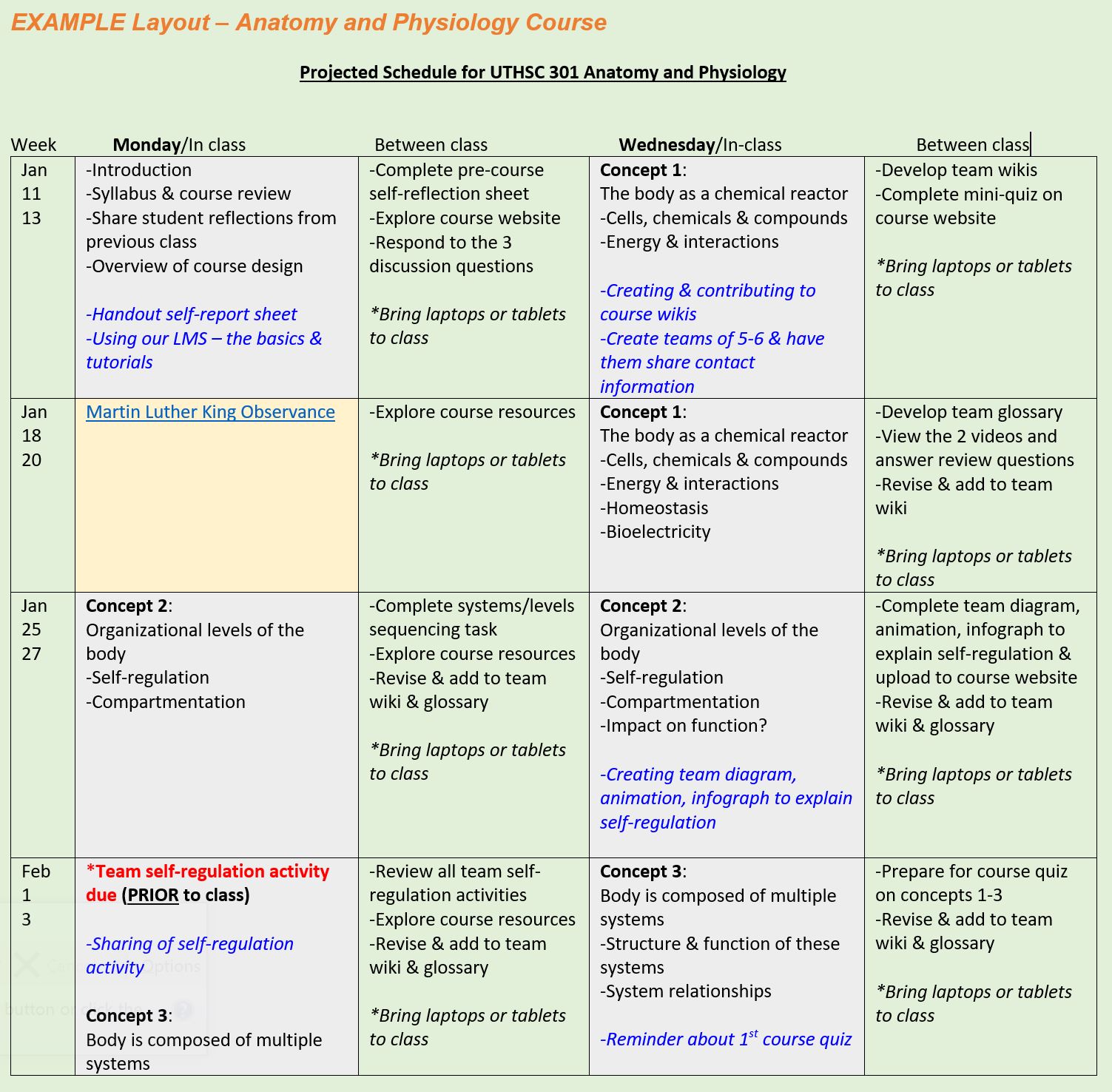
College Specific Guidelines
Dentistry
Your syllabus should be VALUABLE to your students
Ensure your grading policy can clearly differentiate between different standards of performance
Course policies and procedures should establish clear protocols and expectations for the students and instructors
The projected course schedule enables students to better manage their time across the semester
